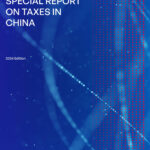China stands as a bustling epicenter for businesses across a wide range of industries, for foreign investors to partake in its growth and opportunities. If you are at the crossroads of business expansion into China’s vibrant and ever-evolving market, it is critical to understand the intricacies and implications involving import taxes in China.
This article will delve into the fundamental categories of import taxes that one should anticipate when conducting business in China, as well as the ways to estimate your potential tax liability. Should you have any inquiries or further clarification regarding import taxes, reach out to one of our experts today.
Does China Charge VAT on Imports?
China does in fact enforce a value-added tax(VAT), that applies to a broad spectrum of imported goods and services, including the sale or importation of physical goods, provision of services, and the sale of intangible and immovable property.
The VAT rate that your business will be liable for is dependent on the nature of the specific business activities being conducted. Below is a general breakdown of the VAT rates:
- Sales of Importation Goods – 13%
- Sales of Necessity Importation Goods – 9%
- Repair, Replacement, and Processing Services – 13%
- Property Leasing Services – 13%
- Transportation Services – 9%
- Telecommunication, Financial, Consumer, and Modern Services – 6%
It is important to mention that certain sales are exempt from VAT, which include services related to Research and Development (R&D), energy performance, software, design, information system, offshore outsourcing, and circuit design services.
Additionally, business owners and foreign investors may be eligible to claim a VAT credit for when your input VAT (the price at which you purchase goods) is in excess of output VAT (the price at which you sell your goods or services). China’s VAT rebate system is beneficial in aiding business owners in mitigating the risk of double taxation.
Be sure to request our Special Report on Taxes in China – 2023 here!

Special Report on Taxes in China
With China holding an increasingly significant position in the global economy, it is important...
Read moreChina Custom Duty Rates
China’s custom duty taxation system assesses duty taxes based on the quantity and type of goods imported. This system can be grouped into six primary categories, each with distinct implications:
- General Duty – Goods originating from countries outside of China’s 17 Free Trade Agreements or other relevant treaties are classified as general duty goods.
- Most Favored Nation Duty – In the absence of a bilateral trade agreement from the country of origination, most favored nation duty rates are determined based on the rates established by the World Trade Organization.
- Conventional Duty – The category encompasses goods imported to China from countries with regional trade agreements containing preferential import tax rate provisions.
- Special Preferential Duty – Specific goods are subject to lower tax rates when compared to most favored nation duty and conventional duty taxes. To qualify for this category, countries must have trade agreements that incorporate special preferential duty provisions.
- Tariff Rate Quota Duty – Goods such as wheat, corn, sugar, wool, fertilizer, rice, and cotton imported within the quota fall under this category.
- Temporary Duty – China retains the authority to impose special duty taxes as a means to regulate demand.
It is critical for businesses engaged in importing to gain a comprehensive understanding of the trade agreements that China has established with countries from which goods are sourced. By doing so, you may discover existing trade agreements that can alleviate the custom duty tax burden.
The Consumption Tax for Imported Goods
Business owners should also be aware of the potential implications of consumption taxes when operating in China. These taxes come into play when specific taxable products are imported into China, including items such as tobacco, alcohol, luxury goods, cosmetics, expensive vehicles, and jewelry. The applicable tax rate on these goods is dependent on the nature of the imported good.
To calculate the consumption tax, there are three primary methods: ad valorem, quantity purchased, and compound tax. Below is an overview of each method:
1. Ad Valorem Method: The taxable sales amount is multiplied by the applicable tax rate to determine the total consumption tax value.
Sales amount x applicable tax rate = Total consumption tax payable
- The Quantity Purchased Method: This approach identifies the tax amount per unit, which is then multiplied by the quantity of goods sold to ascertain the total tax due.
Quantity of sales x sales amount = total consumption tax payable
- Consumption Tax Method: As the most intricate and complex method of the three, the consumption tax method involves a two-step calculation process. First, the taxable sales amount is multiplied by the tax rate. Subsequently, this result is added to the figure derived from multiplying the taxable sales quantity by the tax amount per unit.
Sales amount x applicable tax rate + sales quantity = total consumption tax payable
Additional Types of Import Taxes
Beyond the notable import tax categories outside of VAT, duty, and consumption taxes, there are other tax obligations that you should be aware of, such as:
- Cross Border E-Commerce Import Tax – which is applicable to goods purchased from merchants registered within the cross-border e-commerce network. Furthermore, goods acquired from overseas vendors utilizing courier companies for shipment may also be subject to this tax.
- Industry-Specific Taxes: You may encounter additional taxes specific to your sector of operation. Examples include tobacco tax, environmental protection tax and resource tax.
How to Calculate Taxes on Imports in China
Given China’s multifaceted tax landscape involving multiple import taxes, calculating your gross import tax burden can be confusing. We have provided a step-by-step guide to determine the amount of import tax payable to alleviate any confusion and ensure precision in your calculation:
- Find the Harmonized System (HS) Code – Begin your calculation by locating the HS code for your imported product. Various online lookup tools, such as those available on the World Customs Organization’s website or China Customs’ website can assist you in this endeavor. The HS code serves the critical function of classifying the product and assigning a corresponding tax rate.
- Identify the Tax Category – Determine the specific category of import taxes applicable to specific goods. This may include VAT, customs duty, or consumption tax. It is important to note that your products may be subject to more than one category of tax, therefore detailed assessment is imperative.
- Determine the Customs Value – Accurately calculate the overall value of your product. The includes not only the unit price but all related expenses, including shipping and insurance costs. Import taxes are generally calculated based on the gross value of your goods, and not solely on the unit price.
- Calculate the Applicable Tax – Multiply the applicable tax rate by the total value of your goods. In cases where you are calculating consumption taxes, there is the flexibility in choosing the method that best aligns with your situation.
- Utilize Exemptions – China’s tax system includes provisions that grant exemptions and deductions for specific imported goods. If your goods fall into one of these categories, it is well advised to claim all exemptions and deductions available to optimize tax liability.
Maintaining strict adherence to the regulatory frameworks set forth by the Chinese Government necessitates an accurate calculation of your import taxes. If you encounter any challenges in determining the appropriate tax rates, or evaluating the gross value of your imports, promptly engage the services of a qualified accounting expert.
Closing Remarks
Accurate comprehension and the proficient calculations of import taxes in China stands as an integral facet to conducting business in the dynamic market. The ever-changing nature of China’s tax landscape underscores the importance of staying well-informed regarding applicable tax rates and exemptions pertinent to your business operations.
Our team of experts are adept at supporting businesses in China with navigating the intricacies of the tax landscape. Our expertise and commitment to excellence in accounting, corporate services and tax advisory is backed by over a decade of experience. Contact us for more information on our services.





